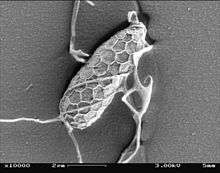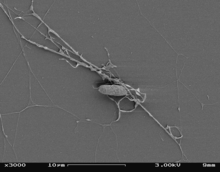Labyrinthulomycetes
The Labyrinthulomycetes (ICBN) or Labyrinthulea[1] (ICZN) are a class of protists that produce a network of filaments or tubes,[2] which serve as tracks for the cells to glide along and absorb nutrients for them. The two main groups are the labyrinthulids (or slime nets) and thraustochytrids. They are mostly marine, commonly found as parasites on algae and seagrasses or as decomposers on dead plant material. They also include some parasites of marine invertebrates.[3]
| Labyrinthulomycetes | |
|---|---|
 | |
| Cell with network of ectoplasmic filaments (Aplanochytrium sp.) | |
| Scientific classification | |
| Phylum: | Heterokontophyta |
| Class: | Labyrinthulomycetes Arx, 1970, Dick, 2001 |
| Genera | |
| |
| Synonyms | |
| |
Characteristics
Although they are outside the cells, the filaments of Labyrinthulomycetes are surrounded by a membrane. They are formed and connected with the cytoplasm by a unique organelle called a sagenogen or bothrosome. The cells are uninucleated and typically ovoid, and move back and forth along the amorphous network at speeds varying from 5-150 μm per minute. Among the labyrinthulids, the cells are enclosed within the tubes, and among the thraustochytrids, they are attached to their sides.
Classification
Labyrinthulomycetes/Labyrinthulea used to belong to the defunct fungal phylum Labyrinthulomycota.[4] They were originally considered unusual slime moulds, although they are not very similar to the other sorts. The structure of their zoospores and genetic studies show them to be a primitive group of heterokonts, but their classification and treatment remains somewhat unsettled.
This class has usually two orders, Labyrinthulales and Thraustochytriales (ICBN), or Labyrinthulida and Thraustochytrida (ICZN),[5] but a third has recently been proposed.[6][7][8]
- Genus Stellarchytrium FioRito & Leander 2016
- Family Oblongichytriidae Cavalier-Smith 2012
- Genus Oblongichytrium Yokoyama & Honda 2007
- Order Labyrinthulida Doflein 1901
- Family Aplanochytriidae Leander ex Cavalier-Smith 2012
- Genus Aplanochytrium Bahnweg & Sparrow 1972 [Labyrinthuloides Perkins 1973]
- Family Labyrinthulidae Cienkowski 1867
- Genus Labyrinthomyxa Duboscq 1921
- Genus Pseudoplasmodium Molisch 1925
- Genus Labyrinthula Cienkowski 1864 [Labyrinthodictyon Valkanov 1969; Labyrinthorhiza Chadefaud 1956]
- Family Aplanochytriidae Leander ex Cavalier-Smith 2012
- Order Amphitremida Gomaa et al. 2013
- Family Diplophryidae Cavalier-Smith 2012
- Genus Diplophrys Barker 1868
- Family Amphitrematidae Poche 1913
- Genus Paramphitrema Valkanov 1970
- Genus Archerella Loeblich & Tappan 1961
- Genus Amphitrema Archer 1867
- Family Diplophryidae Cavalier-Smith 2012
- Order Thraustochytriida Alderman & 1974
- Genus Pyrrhosorus Juel 1901
- Genus Thanatostrea Franc & Arvy 1969
- Family Althorniidae Cavalier-Smith 2012
- Genus Althornia Jones & Alderman 1972
- Family Sorodiplophryidae Cavalier-Smith 2012
- Genus Sorodiplophrys Olive & Dykstra 1975
- Family Amphifilidae Cavalier-Smith 2012
- Genus Amphifila Cavalier-Smith 2012
- Genus Fibrophrys columna Takahashi et al. 2016
- Family Thraustochytriidae Sparrow ex Cejp 1959
- Genus Japonochytrium Kobayasi & Ôkubo 1953
- Genus Monorhizochytrium Doi & Honda 2017
- Genus Sicyoidochytrium Yokoy., Salleh & Honda 2007
- Genus Aurantiochytrium Yokoy. & Honda 2007
- Genus Ulkenia Gaertn. 1977
- Genus Parietichytrium Yokoy., Salleh & Honda 2007
- Genus Botryochytrium Yokoy., Salleh & Honda 2007
- Genus Schizochytrium Goldst. & Belsky emend. Booth & Mill.
- Genus Thraustochytrium Sparrow 1936
- Genus Hondaea Amato & Cagnac 2018
- Genus Labyrinthulochytrium Hassett & Gradinger 2018[9]
Genetic code
The labyrinthulomycete Thraustochytrium aureum is notable for the alternative genetic code of its mitochondria which use TTA as a stop codon instead of coding for Leucine.[10] This code is represented by NCBI translation table 23, Thraustochytrium mitochondrial code.[11]
| Genetic code | Translation table | DNA codon | RNA codon | Translation with this code | Standard code (Translation table 1) | |||
|---|---|---|---|---|---|---|---|---|
| Thraustochytrium mitochondrial | 23 | TTA | UUA | STOP = Ter (*) | Leu (L) | |||
Gallery
 Aplanochytrium sp. under light microscope
Aplanochytrium sp. under light microscope Aplanochytrium sp. under SEM
Aplanochytrium sp. under SEM Aurantiochytrium sp.
Aurantiochytrium sp. Test of Amphitrema, a testate amoeba recently included in the group
Test of Amphitrema, a testate amoeba recently included in the group Leon Cienkowski, polish botanist who in 1867 described Labyrinthula, the first genus of the group[12]
Leon Cienkowski, polish botanist who in 1867 described Labyrinthula, the first genus of the group[12]
References
- Cavalier-Smith, T. (1997). "Sagenista and bigyra, two phyla of heterotrophic heterokont chromists". Archiv für Protistenkunde. 148 (3): 253–267. doi:10.1016/S0003-9365(97)80006-1.
- Tsui CK, Marshall W, Yokoyama R, et al. (January 2009). "Labyrinthulomycetes phylogeny and its implications for the evolutionary loss of chloroplasts and gain of ectoplasmic gliding". Mol. Phylogenet. Evol. 50 (1): 129–40. doi:10.1016/j.ympev.2008.09.027. PMID 18977305.
- Schärer, L.; Knoflach, D.; Vizoso, D. B.; Rieger, G.; Peintner, U. (2007). "Thraustochytrids as novel parasitic protists of marine free-living flatworms: Thraustochytrium caudivorum sp. nov. Parasitizes Macrostomum lignano" (PDF). Marine Biology. 152 (5): 1095. doi:10.1007/s00227-007-0755-4.
- Bennett, Reuel M; Honda, D; Beakes, Gordon W; Thines, Marco (2017). "Labyrinthulomycota". Bennett RM, Honda D, Beakes GW, Thines M. (2017) Labyrinthulomycota. In Handbook of the Protists. Archibald, Simpson, Slamovits (eds). Springer. 507-542. p. 507. doi:10.1007/978-3-319-28149-0_25. ISBN 978-3-319-28147-6.
- "www.ncbi.nlm.nih.gov". Retrieved 2009-04-04.
- Gomaa; Mitchell; Lara (2013). "Amphitremida (Poche, 1913) Is a New Major, Ubiquitous Labyrinthulomycete Clade". PLoS ONE. 8 (1): e53046. Bibcode:2013PLoSO...853046G. doi:10.1371/journal.pone.0053046. PMC 3544814. PMID 23341921.
- ANDERSON; CAVALIER-SMITH (2012). "Ultrastructure of Diplophrys parva, a New Small Freshwater Species, and a Revised Analysis of Labyrinthulea (Heterokonta)". Acta Protozoologica. 8 (1): 291–304. doi:10.4467/16890027AP.12.023.0783. Retrieved 2016-04-04.
- FioRito, Rebecca; Leander, Celeste; Leander, Brian (2016). "Characterization of three novel species of Labyrinthulomycota isolated from ochre sea stars (Pisaster ochraceus)". Marine Biology. 163 (8): 170. doi:10.1007/s00227-016-2944-5.
- Hassett, Brandon T.; Gradinger, Rolf (2018). "New Species of Saprobic Labyrinthulea (=Labyrinthulomycota) and the Erection of a gen. nov. to Resolve Molecular Polyphyly within the Aplanochytrids". Journal of Eukaryotic Microbiology. 65 (4): 475–483. doi:10.1111/jeu.12494. hdl:10037/13570. ISSN 1550-7408.
- Wideman, Jeremy G.; Monier, Adam; Rodríguez-Martínez, Raquel; Leonard, Guy; Cook, Emily; Poirier, Camille; Maguire, Finlay; Milner, David S.; Irwin, Nicholas A. T.; Moore, Karen; Santoro, Alyson E. (2019-11-25). "Unexpected mitochondrial genome diversity revealed by targeted single-cell genomics of heterotrophic flagellated protists". Nature Microbiology. 5 (1): 154–165. doi:10.1038/s41564-019-0605-4. ISSN 2058-5276.
- Elzanowski A, Ostell J, Leipe D, Soussov V. "The Genetic Codes". Taxonomy browser. National Center for Biotechnology Information (NCBI), U.S. National Library of Medicine. Retrieved 11 August 2016.
- Cienkowski, L. (1867). Ueber den Bau und die Entwicklung der Labyrinthuleen. Arch. mikr. Anat., 3:274, .